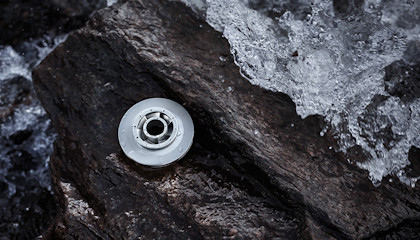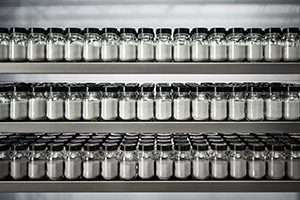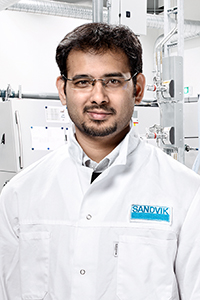Pioneering 3D printing in super-duplex stainless steel

Sandvik has ventured where no other company has gone: it has successfully 3D-printed components in super-duplex stainless steel. The innovation opens up exciting opportunities for offshore industrial segments.
The use of iron-based and highly corrosion-resistant materials in additive manufacturing (AM) has seen significant growth in interest during the past few years. This is largely due to the needs of demanding industries such as the offshore and marine segments, where challenging environments call not only for advanced materials but also for on-demand production of spare parts to minimize stock and reduce material waste.

In terms of withstanding harsh elements, there is one material family that stands out. Osprey® 2507 is a super-duplex alloy with excellent corrosion resistance and outstanding mechanical strength, produced and optimized for 3D printing by the leading materials experts at Sandvik Additive Manufacturing. For decades, Sandvik has been leading the materials evolution for duplex stainless steels, continually launching new duplex and super-duplex materials with improved properties. The offering became even stronger in 2019, when Sandvik acquired a significant stake in the BEAMIT Group, the world’s largest independent AM service provider. The BEAMIT Group supports the most demanding industries with high-end metal components.
First to market
Sandvik super-duplex stainless steels are already successfully used in highly corrosive environments such as the seawater-exposed offshore energy sector and in demanding chemical processing. Predominantly used in the shape of seamless tubes, plates and bars, super-duplex steel has proved a challenge in additive manufacturing. The complexity with two different phases in super duplex, austenite and ferrite, makes it difficult to 3D-print without cracks. In addition, the heat treatment must be controlled afterward to obtain a 50/50 percent microstructure.
 Mikael Schuisky
Mikael Schuisky
“We are proud to say that Sandvik is the first to offer 3D-printed super-duplex components to the market,” says Mikael Schuisky, VP and Business Unit Manager at Sandvik Additive Manufacturing. “While many have tried and failed, we are very pleased to have seen components printed to a standard that doesn’t just meet but also outperforms that of several conventionally manufactured counterparts.”
Secret to success
Nikhil Dixit is an Application Engineer at Sandvik Additive Manufacturing . He has been heavily involved with the development of process parameters and material qualifications for the 3D printing of super-duplex stainless steels.
How do you successfully print super-duplex components, and how do they differ from those of conventionally manufactured parts?
“There’s more to additive manufacturing than printing alone. We take pride in using and manifesting our ‘plan it, print it, perfect it’ approach, stating that printing is just one of several steps you need to master in order to succeed in the industrialization of additive manufacturing. This philosophy has been ever present in this process. Using premium raw materials is essential in order to obtain a high-quality printed component. And the super-duplex metal powder produced and optimized for 3D printing within Sandvik definitely stands out in terms of powder characteristics and low oxygen levels. In terms of tensile impact and corrosion properties, additively manufactured super-duplex stainless steel doesn’t just meet the performance of conventionally manufactured components but actually exceeds it. We have observed components that are near fully dense (>99.9%) and crack free – even before post processing.”
The implementation of 3D-printed super-duplex could have a revolutionary impact on profitability and performance alike.
 Nikhil Dixit
Nikhil Dixit
What is the potential related to additively manufactured super-duplex, other than that of the material itself?
“The industries where super-duplex stainless steel is the material of choice will also enjoy the benefits of implementing additive manufacturing. AM is seen as a disruptive technology across a variety of business segments, enabling performance optimization and reduced material waste and environmental impact as well as on-demand production. In the offshore industries specifically, I would say the implementation of 3D-printed super-duplex – including on-demand production of spare parts, decreased stockkeeping and timely deliveries – could have a revolutionary impact on profitability and performance alike.”
Where does Sandvik go from here?
“We are very excited to partner up and get down to business with customers across the various offshore segments to experience this in full effect. Apart from that, together with BEAMIT, we are already hard at work developing print parameters for multiple-laser machines in order to expand our offering to include even larger applications, which will allow even more customers to implement AM into their operations. Acting on this rapidly expanding market, and in such an innovative environment, I definitely feel confident to say this is only the beginning.”
Plan it, print it, perfect it
In additive manufacturing, printing makes up just one of seven steps you need to master. The steps before and after the printing are equally important.
Plan it
1. Selecting what to print
We help identify which components are both suitable and profitable to print. Since we are also the leading experts on subtractive manufacturing, such as metal cutting, we are equally expert at telling you when not to use additive manufacturing.
2. Material selection
In what environment does your component exist? Based on our 150-year material knowledge and in-house powder manufacturing capabilities, we are expert at matching material to application. We offer the widest range of AM-alloys around and even customize materials.
3. Design and modelling
We have worked in close collaboration with industries like automotive, medical, aerospace and power generation for decades – to understand their material challenges and learn about their applications. When designing for additive it takes metallurgical knowledge to know, for example, how thinly a component can be printed.
4. Choice of optimal AM technology
Being independent is important to us. With all major printing technologies for metals in-house, it means that you can always trust that we choose the optimal process for your component.
Print it
5. Additive manufacturing
All additive manufacturing processes feature layer-by-layer fabrication of three-dimensional objects, but production techniques vary. Printing systems can be classified either by their energy source or the way the material is being joined, for example using laser or a binder. We always develop the right printing parameters so that your product gets the optimum properties.
Perfect it
6. Post-processing
To achieve required properties, it is almost always necessary to post-process components produced with additive manufacturing. We have more than 75 years of leading expertise in post processing methods, such as machining.
7. Testing and quality assurance
Traceability, testing and documentation. Our quality assurance practices were established many decades ago to satisfy the most demanding customers within critical industries such as nuclear, medical, aerospace, automotive, chemical, and oil and gas.